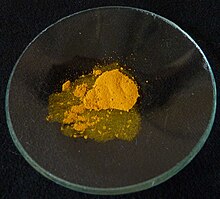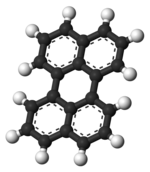| |||

| |||
| Names | |||
|---|---|---|---|
| Preferred IUPAC name
Perylene[2] | |||
| Other names
peri-Dinaphthalene; Perilene; Dibenz[de,kl]anthracene
| |||
| Identifiers | |||
3D model (JSmol)
|
|||
| 1911335 | |||
| ChEBI | |||
| ChEMBL | |||
| ChemSpider | |||
| ECHA InfoCard | 100.005.365 | ||
| EC Number |
| ||
| 104944 | |||
| KEGG | |||
PubChem CID
|
|||
| RTECS number |
| ||
| UNII | |||
CompTox Dashboard (EPA)
|
|||
| |||
| |||
| Properties | |||
| C20H12 | |||
| Molar mass | 252.316 g·mol−1 | ||
| Appearance | Brown solid | ||
| Melting point | 276 to 279 °C (529 to 534 °F; 549 to 552 K) | ||
| -166.8·10−6 cm3/mol | |||
Except where otherwise noted, data are given for materials in their standard state (at 25 °C [77 °F], 100 kPa).
| |||
Perylene or perilene is a polycyclic aromatic hydrocarbon with the chemical formula C20H12, occurring as a brown solid. It or its derivatives may be carcinogenic, and it is considered to be a hazardous pollutant. In cell membrane cytochemistry, perylene is used as a fluorescent lipid probe. It is the parent compound of a class of rylene dyes.
- ^ Perylene at Sigma-Aldrich
- ^ International Union of Pure and Applied Chemistry (2014). Nomenclature of Organic Chemistry: IUPAC Recommendations and Preferred Names 2013. The Royal Society of Chemistry. p. 206. doi:10.1039/9781849733069. ISBN 978-0-85404-182-4.

